The 8 Most Surprising Things About the Nikon Zf
There are a few things that reading reviews and doing my homework didn’t quite prepare me for until I actually used this camera.
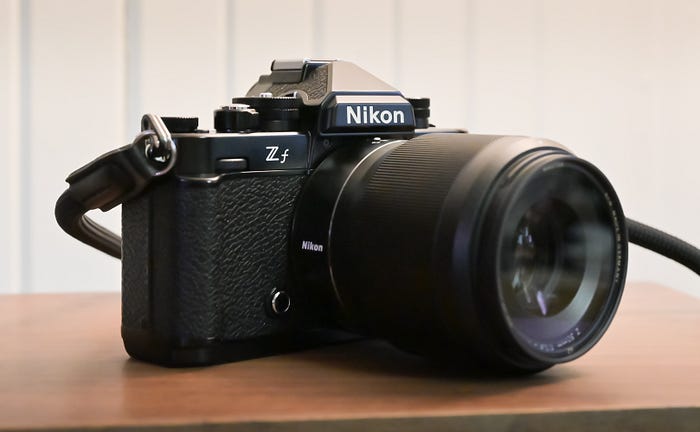 The product release cycle for new cameras follows a predictable cadence, driven either by the continual need to one-up the competition on some spec or feature or by the fear that someone on social media might suggest that Brand N is teetering on the brink of financial ruin if they take more than twenty minutes to announce their response to Brand C’s latest offering. The result is often a camera that delivers incremental improvements over its predecessor, offering more megapixels or perhaps the ability to automatically focus on the eyes of the Short-beaked Echidna while ignoring the Numbat standing next to it, which is sure to be an indispensable feature on your next trip to Australia.
The product release cycle for new cameras follows a predictable cadence, driven either by the continual need to one-up the competition on some spec or feature or by the fear that someone on social media might suggest that Brand N is teetering on the brink of financial ruin if they take more than twenty minutes to announce their response to Brand C’s latest offering. The result is often a camera that delivers incremental improvements over its predecessor, offering more megapixels or perhaps the ability to automatically focus on the eyes of the Short-beaked Echidna while ignoring the Numbat standing next to it, which is sure to be an indispensable feature on your next trip to Australia.
But now and then, someone unveils a camera that makes photographers sit up and take notice. Fujifilm did it with their first X-T, X-Pro, and X100 series cameras, which delivered on both form and function. Olympus did it with their digital PEN-F, a tiny work of art combining unique features with a refined industrial design. Not coincidentally, these cameras featured a retro aesthetic that resonated with many photographers who had come to appreciate the pleasing design and functional advantages of the best 35mm film cameras.
Nikon’s Retro History
In 2013, Nikon gave retro a whirl with the somewhat polarizing Df, a camera that puzzled some and delighted others and has since become a bit of a cult classic among its fans. In 2021, they gave us the Zfc, an APS-C camera that delivered on the looks but lacked the premium feel buyers wanted.
And then, in September 2023, Nikon revealed the Zf, a camera that has enjoyed an overwhelmingly positive initial response from reviewers and photographers alike. There is no shortage of information on (or opinions of) this camera, so my goal here is to share a few things that either came as a surprise to me when I picked up my Zf from my local camera store or I feel haven’t been sufficiently addressed and, therefore, might come as a surprise to someone using this camera for the first time.
Surprise #1: This is Not a Compact Camera
Perhaps this shouldn’t have come as a surprise, as the dimensions and weight of the Zf have been published for some time, and many reviewers have made this point. Still, the retro design and the smallish Nikon Z 28mm and 40mm lenses that pair up so well with this camera led me to believe the Zf would be smaller than it actually is.
I don’t see this as a bad thing, just one that caught me off guard, which brings me to my next observation.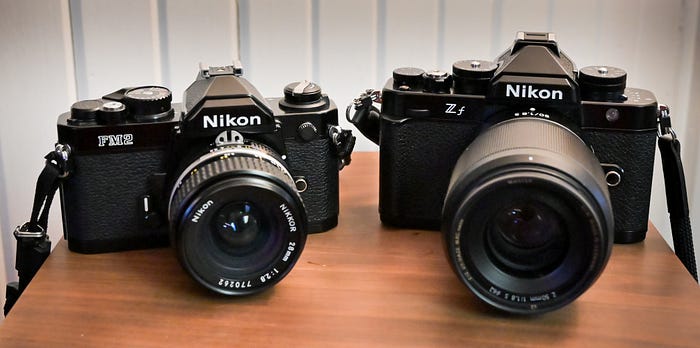 My Nikon FM2-n on the left, purchased brand-new in 1992 and still in regular use, with the Nikkor 28mm f/2.8 AI-S lens attached, alongside my new Nikon Zf with the Z 50mm f/1.8 lens on the right.
My Nikon FM2-n on the left, purchased brand-new in 1992 and still in regular use, with the Nikkor 28mm f/2.8 AI-S lens attached, alongside my new Nikon Zf with the Z 50mm f/1.8 lens on the right.
Surprise #2: The Feel and Build Quality are Exceptional
The first thing you notice when you pick up a Zf is the weight. It is heavier than I expected and has a substantial “carved-from-a-single-piece-of-something” feel that is very hard to describe until you hold one. There is density here. It says, “I’m built to last.”
The top plate dials are brass and operate with feedback and precision that suggests some genuine mechanical goodness is hidden beneath them. If how a camera and its controls feel is important to you, the Zf should be a real treat. And, though it looks plenty handsome in the photos I’ve seen, it is even nicer firsthand, where it’s easy to appreciate the thought and detail Nikon put into this camera. Some will argue that looks are superficial and don’t matter, but I disagree; seeing this camera on my desk, even as I write this, makes me want to pick it up and head out to make pictures.
And, though it looks plenty handsome in the photos I’ve seen, it is even nicer firsthand, where it’s easy to appreciate the thought and detail Nikon put into this camera. Some will argue that looks are superficial and don’t matter, but I disagree; seeing this camera on my desk, even as I write this, makes me want to pick it up and head out to make pictures.
Surprise #3: The Image Quality is REALLY Good
I have always been pleased with just how easy it is to work with Nikon’s NEF (RAW) files and equally impressed by the quality (and workability) of their out-of-camera JPGs. I find Nikon’s JPGs and colors among the best of any camera brand, so my expectations were high.
What I wasn’t prepared for was just how good the images from the Zf are, particularly in low-light situations. I’m used to this sensor from the Nikon Z6 and have always been pleased with it, but Nikon has sprinkled some magic fairy dust into the Expeed 7 processor, and the resulting images are exceptional.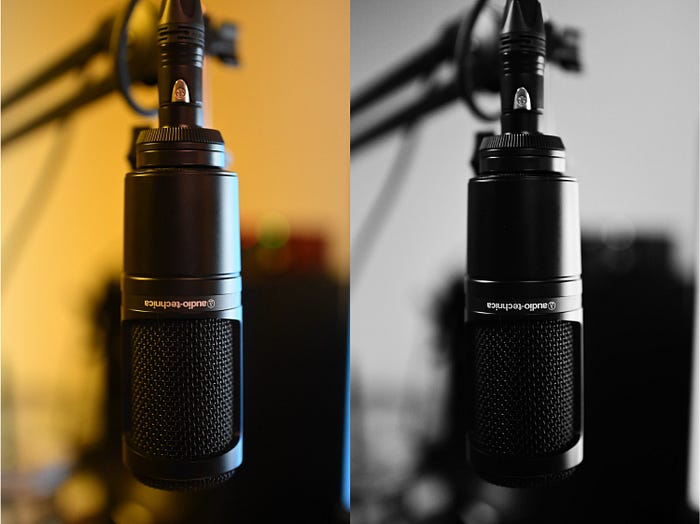 Color and monochrome versions of the same image, straight out of the camera with no adjustments, shot hand-held at ISO 12,800 with the Zf and the Z 50mm f/1.8.
Color and monochrome versions of the same image, straight out of the camera with no adjustments, shot hand-held at ISO 12,800 with the Zf and the Z 50mm f/1.8.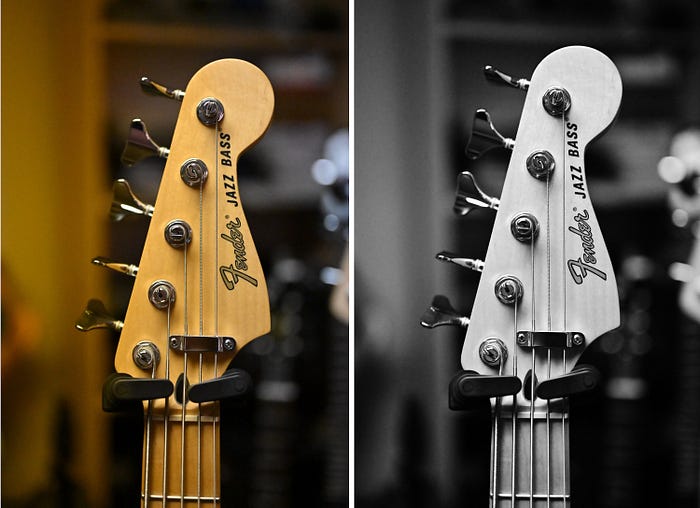 Another example of identical images shot in color and monochrome, straight out of the camera with no adjustments, hand-held at ISO 25,600 with the Zf and the Z 50 mm 1/1.8.
Another example of identical images shot in color and monochrome, straight out of the camera with no adjustments, hand-held at ISO 25,600 with the Zf and the Z 50 mm 1/1.8.
Surprise #4: I’ll Need a Grip — Your Mileage May Vary
I realize how a camera feels in hand is highly subjective. I don’t have big hands, and I have the beginnings of arthritis, which complicates matters a bit. The deep grips on my Nikon Z6, Olympus OM-1, and Fujifilm X-S10 make them very easy to carry one-handed. When I had a Fujifilm X-E4, which entirely lacked a front grip, I had no issues carrying it all day long, but that was a much smaller and lighter camera than the Zf.
The Zf has a small, molded grip on the front and nothing beyond a textured surface on the back, which I find uncomfortable and provides no feeling of having it securely in hand. I didn’t need to take it out shooting to realize that I wanted the SmallRig grip, which I ordered immediately.
Do I wish Nikon had made the grip bigger? Actually, no. I grumbled a bit at first, thinking it was a mistake to let function follow form, then realized the design as-is works for many users, and offering the optional grip broadens the Zf’s appeal without compromising its aesthetics.
Surprise #5: Those Dials Are Not These Dials
This wasn’t a surprise for me, but only because I owned a Nikon Df and was forced to get my head around this concept back then. For anyone who has not used a Df (or a Zfc), this, more than any other aspect of the Zf, can lead to frustration and disappointment unless you take time to understand how they work and adjust your expectations accordingly.
On Fujifilm bodies that lack a PASM mode dial, the exposure triangle — aperture, shutter speed, and ISO — is controlled by dedicated dials, including an aperture ring on most Fujinon lenses.
Set them all to “A,” and you’re in program mode. Move the aperture ring away from “A,” and you’re shooting in aperture priority. Leave the aperture ring on “A” and move the shutter speed dial, and now you’re in shutter priority mode. Move the ISO dial away from “A,” and you’re instantly out of auto ISO and able to specify a value. When none of the dials are set to “A,” you’re in full manual mode.
Not so with the Zf, which has a PASM dial for choosing between program, aperture priority, shutter priority, or manual mode.
Shooting in full manual mode or shutter priority mode poses no issues. When using the shutter speed dial, remember that you are limited to making full stop exposure adjustments unless you set it to “1/3” stop, at which point the dial itself no longer controls shutter speed.
It isn’t until you choose program or aperture priority mode — or you want to use auto ISO — that things begin to unravel a bit.
The problem starts with the aperture ring, specifically the lack of one. Unless you are shooting with older Nikon glass, such as one of the AI, AI-S, AF-D lenses, or certain third-party or adapted lenses, there is no aperture ring, so the front or rear command dial must handle that function. I don’t consider this a big deal, but it is one of the reasons that prevents Nikon from taking the same approach as Fujifilm.
Choosing aperture priority mode means the camera will determine a corresponding shutter speed to ensure proper exposure, effectively taking the shutter speed dial out of the equation. Functionally, that’s easy enough to understand. But because a physical dial not only serves as a control (allowing you to choose a value) but also as an indicator (which displays a value), the shutter speed dial — which lacks an “A” position to remove it from the manual exposure equation — now shows a value that is irrelevant and incorrect.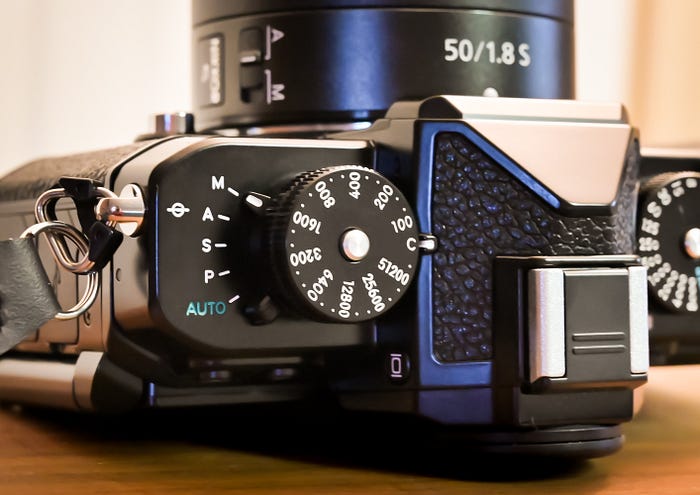 The ISO dial situation is even more nuanced.
The ISO dial situation is even more nuanced.
If you want to use the dial to set your ISO and you’ve disabled auto ISO in the menus, it works exactly as you would expect. If you place the ISO dial in the “C” position, it switches to the value set in the ISO menu so long as auto ISO is disabled, much like every other camera.
If you enable auto ISO, settings in its menu allow you to specify a maximum ISO value and a minimum shutter speed, which, when reached, triggers the camera to raise the ISO value to render a correct exposure. This, too, is precisely how auto ISO works in almost every other camera, including Nikon’s other Z bodies.
But what about the dial when auto ISO is enabled? It can still be set to any ISO value, but the auto ISO algorithm overrides that setting. Much like the shutter speed dial, it looks to be a relevant control but isn’t, and the value it displays is wrong.
When using auto ISO, there is a way to make the ISO dial function as a high ISO limit control. However, it isn’t explained well in the camera’s user manual, and the dial still does not indicate the actual ISO value being used.
Nikon could have gotten around this by adding an “A” position to the ISO dial but didn’t, which I regard as a pretty significant oversight. They could also have provided the option to use the “C” position to enable auto ISO, and still could with a firmware update, I suspect. There is no way to toggle auto ISO on or off with a single step. There are a couple of ways to get to the auto ISO menu without a full dive through the menus, but neither is ideal.
Is this truly problematic? It could be if you’re trying to apply Fujifilm logic to the Zf. If you accept that the Zf uses similar dials but a different paradigm and don’t try to make the Fujifilm square peg fit into the Nikon round hole, then no, it really isn’t. My advice: Accept the Nikon for the unique camera that it is, and don’t let the fact that it marches to its own drum in some ways tarnish your experience with it.
Surprise #6: I Like Adjusting the Focus Point with the Touch Screen
I have a confession: I have a burning dislike for touchscreens. I love my iPhone, but if I could get one with the physical keyboard from my Blackberry Curve from twenty years ago, I would buy it (said the old man shouting at clouds).
It’s not the touchscreen’s fault; people use them all day long with great success. But, for whatever reason, my fingers never land on the right button, key, or icon. Even with auto-correct, my text messages sometimes look like they’ve been written in a completely different language. I’m also lousy with the various swipe gestures of the iPhone. When I want notifications, I get the control panel. When I want the control panel, I get the search page. You get the picture.
With the Zf, Nikon has done away with the joystick, a navigational feature most manufacturers added when they abandoned the trusty D-pad. Depending upon the situation, I typically focus and re-compose, but when focus is supercritical (think close-ups or very shallow depth-of-field situations), I move the focus point around instead. Thus, I was very concerned when I learned I might have to rely on the touchscreen for that function. My other cameras also have touch screens, and I couldn’t disable them fast enough.
As it turns out, this is one of my favorite Zf features. It is way faster and far more precise than fiddling with a joystick, and I have no problem getting it to respond how I want it to.
As a bonus, Nikon lets you adjust which part of the screen gets used for this purpose. I have mine set up to use the upper right section in landscape orientation and the upper left portion in portrait (vertical) orientation, as that’s where my right thumb naturally fell.
Brilliant!
Surprise #7: Adapted Lenses Work Really Well
Many photographers — me included — find great pleasure in adapting older lenses to modern bodies. No, they’re not always as sharp as modern native lenses, and most lack autofocus, but vintage glass, such as the Nikkor manual focus AI and AI-S lenses, are a joy to use. They are mechanical wonders, and their optical formulas and coatings deliver a certain character and vibe that’s been dialed out of today’s offerings. A starburst and a bit of colorful lens flare from the Nikkor 28mm f/2.8 AI-S stopped down to f/16.
A starburst and a bit of colorful lens flare from the Nikkor 28mm f/2.8 AI-S stopped down to f/16.
Nikon knew people would want to mount those lenses up on their Zfs, and they paid particular attention to making sure using them was a positive experience. Focus peaking and the resulting pseudo-depth-of-field preview is especially good on the Zf. As a bonus, if you have eye detect AF enabled, and the camera spots an eyeball in the frame, it points out as the preferred focus point, allowing you to zoom in and nail focus quickly. A fall photo made with the Nikkor 28mm f/2.8 AI-S manual focus lens mounted to the Zf with the FTZ adapter.
A fall photo made with the Nikkor 28mm f/2.8 AI-S manual focus lens mounted to the Zf with the FTZ adapter.
Because of the Z system’s short flange distance, adding an adapter — including Nikon’s own FTZ or FTZ II models — does add some length to any non-native glass, turning lenses like the tiny Nikkor 28mm f/2.8 AI-S I use into a combo that’s nearly the length of the Z 50mm f/1.8, and there’s no way around physics. Still, being able to use those great old lenses with such ease is a real treat.
Surprise #8: The Jekyll and Hyde Effect
This one isn’t as much a functional or hands-on surprise as a commentary on Nikon’s decision to combine a traditional film camera aesthetic and analog controls with incredible performance.
Mind you, I’m not complaining; I think Nikon is to be applauded. It should help keep the internet wags quiet, as one of the criticisms of the Df was that it borrowed things like its autofocus system from the more modest D610 rather than the D750. I never thought the D610 or the Df — both of which I owned and enjoyed — were under-performing cameras in any way, but some critics took issue with the “parts bin” approach in the Df, which was not an inexpensive camera compared to the D610 or D750.
They certainly can’t say that about the Zf.
To make an automotive analogy, the Zf is reminiscent of what is commonly known as a “sleeper,” much like the 1966 Plymouth Fury my aunt drove when I was a kid. From the outside, it looked like a standard-issue government car, complete with dog dish hubcaps and bereft of any chrome or comfort options. But under the hood lurked a 440 cubic inch V8 that would leave shocked muscle car drivers in the dust at traffic lights and caused the magnetic St. Christopher on the (all metal!) dashboard to cover his eyes.
The genius here is that buyers who want a very handsome-looking camera that nails the retro vibe can get it and not concern themselves with using all of the Zf’s features and capabilities. Meanwhile, those looking for a camera with 90% of the Z8’s specs and features can get it for half the cost with the Zf.
In his novella, The Strange Case of Dr. Jekyll and Mr. Hyde, author Robert Louis Stevenson portrays Jekyll and Hyde as two distinct people. One is good, the other evil. There is no gray area, and the two never manifest at the same time. While the Zf has a bit of a split personality, the fact that they peacefully and successfully co-exist broadens the appeal of this camera and will undoubtedly contribute to its success.
Living Happily Ever After with the Nikon Zf
When I bought my Nikon Df several years ago, the aesthetics drew me in. The Df was — and is — a beautiful camera to my eye. As someone who had been shooting Fujifilm cameras for several years, the thought of owning a retro-styled full-frame Nikon with analog controls was irresistible. When I realized Nikon’s implementation of physical dials wasn’t as well executed as Fujifilm’s, I was initially so disappointed that I nearly sent the camera back.
I felt frustrated using the Df until I embraced using it in manual mode and stopped trying to make it work in a way that revealed its shortcomings instead of leveraging its strengths. Only then did I realize its most significant benefit was the 16MP sensor borrowed from the D4, making it a low-light beast that produced uniquely beautiful images.
I feel very much the same way about the Zf.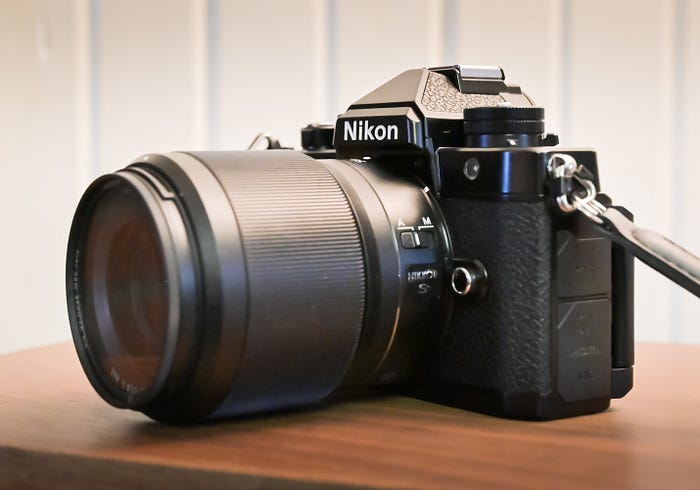 I’ve only had mine for a couple of weeks, and it has taken a bit of getting used to, but each outing makes me like it even more. I have it customized in a way that works for me, and I have found that the muscle memory required to ensure a camera doesn’t get in the way of the creative process is falling into place quicker with this camera than any I’ve owned.
I’ve only had mine for a couple of weeks, and it has taken a bit of getting used to, but each outing makes me like it even more. I have it customized in a way that works for me, and I have found that the muscle memory required to ensure a camera doesn’t get in the way of the creative process is falling into place quicker with this camera than any I’ve owned.
I’ve shot it with the Z 50mm f/1.8 and used the FTZ adapter to mount up some of my favorite older lenses, including my beloved Nikkor 28mm f/2.8 AI-S. Manual focus is a breeze on the Zf, and the results have been great.
If you are looking for a compact, lightweight camera with “what you see is what you get” analog dials that exactly mimic the experience of shooting with a film camera, you may be better served with one of the Fujifilm retro-styled bodies, or if cost is no object, one of the Leica Q cameras.
But if you are looking for a camera that offers some of Nikon’s most advanced technology, performance, and features cloaked in a well-crafted, solid, substantive, and beautiful package at a very reasonable price point, it’s easy to see why the Zf has been so highly praised and well-received.
As for me, this is the beginning of a very fulfilling long-term relationship, and I’ve already decided that the Zf is a camera I will never sell.








































